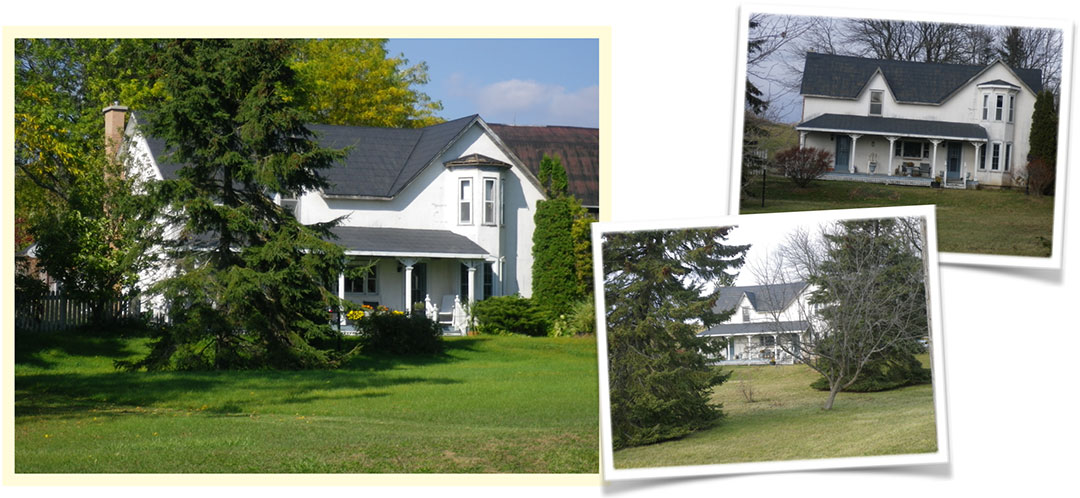164 Morganston Road, Morganston
(c. 1900s)
Roll No. 1411-011-040-07000-0000 – Cramahe Township Ontario

Ontario Farmhouse Vernacular
164 County Road 27, near the hamlet of Morganston is an example of a modified Ontario farmhouse. It may have been brick at one time but appears to be covered in white stucco now. The chimney, which might have helped determine this supposition, is more buff coloured than the ubiquitous red brick of the township. It also appears to be of a newer vintage than the original build date of the house.
There is a two story three panel bay window on the front gable and another gable over an upper bedroom.
The Ontario farmhouse has a broad facade, rather than a single gable end with a rear “tail”. They are usually one and a half stories but may be full two story height.
Many of the traditional Ontario farmhouse have tall pointed Gothic gables (with copious gingerbread), or like this one a broader gable without adornment. This property, like most, has a long front porch sheltering the front door with gingerbread topping the pillars.
Many of the windows, particularly those in the bay window are tall and slender, characteristic of Italianate design.
History or Associative Value
This stately farmhouse was once owned by a member of the French nobility! Charles William Grant (1782-1848) was the 5th Baron de Longueuil, the only currently-extant French colonial title that is recognized by Queen Elizabeth II as Queen of Canada. He succeeded to the title on 17 January 1841. He died on 5 July 1848 at his residence, Alwington House in Kingston, which served as the Vice Regal residence when Kingston was the capital. He did not live in the subject house and we don’t know why he bought it.
Additional Historical and Genealogical Information
164 Highway 27, Morganston, Ontario Cramahe Township, Concession 9, Lot 16
Lot 16, Concession 9 consists of the 200 acres immediately north and east of Morganston. The first five owners of this land were never residents of Cramahe Township. Alexander Chisholm (?-?), who was granted the property by the Crown on 30 June 1801, lived in Hastings County. John Young (1759-1819) of Quebec City bought the property from him on 28 November 1804. On Young’s death on 14 September 1819, the property was inherited by his son Thomas Ainslie Young (1797-1852), also of Quebec City.
The next owner was Charles William Grant (1782-1848, 5th Baron de Longueuil), who acquired the property from Young the younger on 10 February 1823. Grant was a member of the Legislative Council for Lower Canada. On 16 April 1833 he sold the land to William C. Anderson (?-?), an officer in the Royal Artillery and resident of Montreal.
The first Cramahe resident to own Lot 16 was William Snider (1806-?), who bought it from Anderson on 21 March 1850. Snider was a resident of Belleville at the time, but was a Cramahe farmer by 1851. No information has been found about his family, other than the fact that his wife’s name was Amanda.
The 50 acres in the southeastern corner of Lot 19 were sold by Snider to Sylvester Glover (1825-?) on 20 February 1851. Little information has been found about Glover. The 1851 Cramahe census lists him as a farmer, his wife as Almira (1827-?), and his three children as William H. (1842-?), Sarah (1847-?), and Almira (1850-?, “Amanda” in later censuses). By 1861 they were living in Welland, Ontario. There were other Glovers in the Morganston area, but no definitive connection between them and Sylvester has been found. The ages are appropriate for him to have been the brother of David Glover (1832-1892), who owned the adjacent part of Lot 16 from 1866 until his death.
Sylvester Glover sold his 50 acres to George Phinn (1826-1901) on 22 December 1857. Phinn was another farmer, who married Caroline Amanda Mason (1837-1901) in about 1856. Their children were Mary Lucina (1857-1926), George Edward (1858-?), Charlotte A. (1859-?), Luella Ann (1861-?), Amanda Amelia (1863-1919), James H. A. (1866-?), Emma Jane (1868-?), and Francis J. (1873-1903).
George Phinn owned the property for a little over a year, selling it on 19 March 1859 to his brother Jeremiah Phinn (1829-1910). “Jerry” Phinn was also a farmer, married to Alice Richards (1838-1908, m. 1859). Their children were Isadora (1860-?), John H. (1862-?), Judson A. (1864-?), Eliza (1866-?), Annie L. (1866-?), Mary Elizabeth (1866-1945), William F. (1868-?), and Alice Lillian (1875-1919).
Jerry Phinn sold the 50 acres to farmer David Turney (1833-1925) on 30 March 1863. Turney’s wife was Sarah Harriet Reddick (1832-1907, m. 1857), and their children were Luella Calista (1859-1937), Mary J. (1862-1945), Lester George (1863-?), Alberta Sabra (1865-1946), Allen Eskett (1867-1900), Lester Grant (1870-1953), Florence Jane (1872-1925), and David Wallace (1875-1960).
Snider sold the property to Glover for £50 in 1851 and Glover to George Phinn for £150 in 1857. Less than two years later George Phinn sold it to Jerry Phinn for $1500, the equivalent of £375 at the time. Jerry Phinn sold it to David Turney in 1863 for $1200. The jump of over 100% during the tenure of George Phinn might indicate an improvement (house?) to the property, but George was the owner for less than two years. If he didn’t build the house, it was probably built by David Turney sometime after 1863.
Castleton, ON K0K 1M0, Canada
